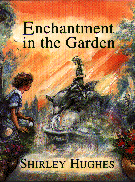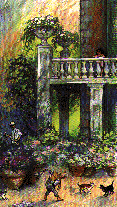


|
Enchantment in the Garden.
Shirley Hughes.
Subject Headings:
Grades 2 and up / Ages 7 and up. ***1/2 /4
|

 Set in the hills of Italy during the early days of this century, Enchantment in the Garden is the story of a statue named Cherubino and Valerie, the lonely girl who brings him to life. Like Mary, the orphan in The Secret Garden and Tom who journeys back in time in search of a friend in Tom's Midnight Garden, Valerie longs for companionship. Her mother, a busy socialite, and her father, a rich businessman, have no time for their young daughter.
Set in the hills of Italy during the early days of this century, Enchantment in the Garden is the story of a statue named Cherubino and Valerie, the lonely girl who brings him to life. Like Mary, the orphan in The Secret Garden and Tom who journeys back in time in search of a friend in Tom's Midnight Garden, Valerie longs for companionship. Her mother, a busy socialite, and her father, a rich businessman, have no time for their young daughter.
English author-illustrator Shirley Hughes, winner of the Kate Greenaway Medal for children's illustration for Dogger, once again creates a charming story that partners beautiful pictures with an appealing text. Hughes establishes a fairy tale stage for her story with the opening words, "Once in an old Italian city in a house with many rooms, there lived a little girl called Valerie." The first sentence echoes the "Once upon a time" of the traditional fairy tale and immediately suggests Valerie's isolation and loneliness in the house with many rooms.
Valerie was an only child. She was too serious for her age and had more toys and dresses than she could possibly need. But she had few friends, and, of course, she was lonely.

With no friends her own age, Valerie spends most of her days alone or in the company of her governess, Miss McKenzie. One day while strolling through a richly ornate Italian garden which had once belonged to a great prince, Valerie comes upon a statue of a beautiful long haired boy riding a dolphin. She talks to the stone statue, claims him as her best friend, christens him with the name Cherubino, and he magically comes to life. But Cherubino, who does not look or act like other children, is immediately taken away to an orphanage where he becomes ill. Rescuing her new friend, Valerie brings him home to work in her family's garden. The garden restores and nourishes Cherubino; his appetite returns, and his cheeks become rosy with good health. But before long, Cherubino realizes that he does not belong in Valerie's world and must return to the sea.
The story embraces the universal themes of loneliness, friendship and loss while, at the same time, it unites some of the conventions of children's literature - statues magically brought to life, enchanted gardens that revive and invigorate, orphanages as institutions of horror and abuse - with a contemporary setting. Hughes' portrayal of Valerie adds a modern dimension to the story. She looks and acts like a real little girl; her unruly curls and glasses suggest her impetuous, inquisitive nature. Her face is full of expression - sadness when she is ignored by her parents - joy when she discovers Cherubino. Valerie's loneliness and search for a friend bond her to the young and older reader. Despite Cherubino's return to the sea, this modern fairy tale has a happy ending when Valerie comes to understand that her friend will always be a part of her.
The full-page pictures reinforce the story's fairy tale element. Bright washes of sunlight and moonlight infuse the illustrations with a magical cast. The lush garden scenes are particularly evocative, their vibrant colours suggestive of the lush Tuscan landscape. Etchings in pen decorate each page, and endpapers depicting the Italian scenery endow the book with a rich ornamental appearance.
This beautiful picture book will appeal to adults as well as children. One small reservation is the book's length, 58 pages, which may be a little long for younger children. But read over a couple of nights, this book is sure to hold a child's attention.
Highly recommended.
Jennifer Sullivan works in the Canadian Literature Research Service of the National Library of Canada.

To comment on this title or this review, send mail to cm@umanitoba.ca.
Copyright © 1997 the Manitoba Library Association. Reproduction for personal use is permitted only if this copyright notice is maintained. Any other reproduction is prohibited without permission.
Published by
The Manitoba Library Association
ISSN 1201-9364
TABLE OF CONTENTS FOR THIS ISSUE - APRIL 11, 1997.
AUTHORS | TITLES | MEDIA REVIEWS | BOOKSHELF | BACK ISSUES | SEARCH | HOME